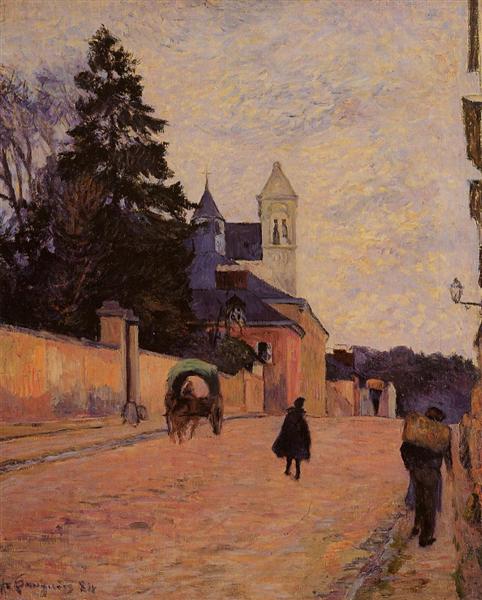Description
In "Calle de Ruan" of 1884, Paul Gauguin offers a fascinating exploration of urban life through its post -impressionist distinctive style, showing how the everyday can be raised to the category of artistic by the deliberate choice of shapes and colors. This work, although less known than its paintings Subsequent in Tahiti, he reveals a key moment in the artist's evolution towards a more symbolic and emotional aesthetic.
The composition of "Calle de Ruan" is remarkable for its treatment of space and perspective, with an approach in the verticality of the buildings that constraint the view and look at the bottom. This composition scheme not only establishes a sense of depth, but also confers an enveloping character to the scene. The warmth of the color, in particular the ocher and yellow tones, contrasts with the shadows of the buildings, creating a dialogue between light and dark that invites the viewer to immerse themselves in the atmosphere of the street.
As for the palette, Gauguin chooses vibrant colors that seem to vibrate on the surface. The combination of saturated colors is characteristic of its style, since it allows transmitting sensations more than a faithful representation of reality. This explosion of color is revealing not only of its mood, but also of its intention to invoke emotions in the viewer. The mystical tones of the work highlight abstract elements, which adds a mystery nuance to the urban scene.
The characters are scarce, but their presence is no less significant. A few figures - among those found, apparently in everyday life - are inserted in the context of the street, providing a sense of scale and humanity to the architectural environment. Gauguin, in this sense, captures the pulse of Rouen's life, but also the fragility of these human interactions in an increasingly industrialized space.
Interestingly, this work can be seen as a bridge between the realism of the painting of the time and the exploration of the symbolic, a transition that Gauguin would deepen in his subsequent works, especially in the landscape and culture of Polynesia. His interest in flat colors and simplified contours is anticipated in "Calle de Ruan", foreshadowing his famous search for the essential and primitive that will characterize his work in the future.
In "Calle de Ruan", Gauguin intertwines with the legacy of impressionism, however, he distances himself from the mere capture of light and movement, focusing on a more intense representation of the emotional experience of the environment. This work, although of an early period, marks a milestone in the characteristic search of Gauguin for the meaning in everyday life and the focus on the essence of life, an issue that would continue to explore in the rich iconography of his later career.
KUADROS ©, a famous paint on your wall.
Hand-made oil painting reproductions, with the quality of professional artists and the distinctive seal of KUADROS ©.
Reproduction service paintings With a guarantee of satisfaction. If you are not completely satisfied with the replica of your painting, we refund your money 100%.

